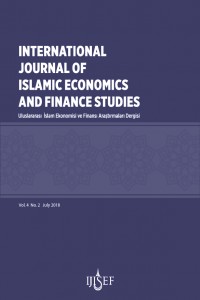Öz
In the name of Allah, the Most Compassionate, the Merciful. This paper seeks to accomplish several goals. First, it addresses in brief the Waqf as an effective Islamic financing institution to reduce poverty and improving human wellbeing. Second, it explains Waqf linguistically and terminology types of Waqf and their practicing throughout history: Third it proposes a framework of Waqf Governance. It contains a structure of several levels; Tawhid, the basic principles of good governance, shared vision and mission, strategy formation, strategy implementation and control, the level of monitoring, Shari'ah auditing, Shura Boardand the investment monitoring unit. It points out to the social and economic impacts of good governing. Social Then and economic implications of good governing make a crucial factor in the development of Waqf. Finally, this paper proposes a structure and function for Waqf funds investment called Waqf Investment Institutions (WIIs) that are setup, mainly as organizations of Waqf fund planners and managers. Each WII operates one or more funds. Each WII shall be obliged to invest fraction of its portfolio in its locality to assure regional growth and development. WII may issue Waqf shares, Istibdal (Substitution of Waqf Prosperities), lease with dual payment, Huker (long lease with large advanced lump sum, and Al Mursad (loan). This loan is offered to the Waqf management by a lender to develop a Waqf. This requires organizing WII in a corporate fashion. Current regulations on investment may need some adjustments to cater for such businesses. WIIs will be joined in a national association that promotes them in the market and help regulating such business.
Anahtar Kelimeler
Waqf Governance Investment Social Economic Institutions Shari’ah Islamic Finance
Kaynakça
- Chowdhury, Md. Shahedur Rahman, et. al (2011). Economic of Cash WAQF Manegment in Malaysia: A proposed Cash WAQF model for practitioners and future researchers. African Journal of Business Management, 5 (30). Cizakca, Murat, (1998). Awqaf in History and Its Implications for Modern Islamic Economies. Islamic Economies Studies, 6 (1). (Jeddah: IRTI & IDB). Hoextor, M. (1998). Waqf Studies in the Twentieth Century: The state of the Art, Journal of the economic and social History of the Orient, Vol. 41. Pp.476-495. _________. (2004). Incorporated Cash Waqfs and Mudaraba, Islamic Non _bank Financial Instruments from the past to the future. (Turkey: Bahcesehir University). ___________, (2010). Incorporated Cash Waqfs and Mudaraba, Islamic Non _bank financial instruments. Mohammed MTSH, (2008), sustaining the Means of Sustainability: The Need for Accepting Wakf (Waqf) Assests in Malaysian property Market. A paper presented in The 14th Annual Conference of the Pacific Rim Real Estate Society, Kuala Lumpur, Malaysia. Monzer Kahf (1999) Towards the Revival of Awqaf: A Few Fiqhi lssues to Reconsider, Presented at the Harvard Forum on Islamic Finance and Economics, October 1, 1999, Harvard University U.S.A. Obaidullah, Mohammed, (2014), A Framework for Analysis of Islamic Endowment (Waqf) Laws, Working Paper, Islamic Research Training Institute, the Islamic development Bank. Sadeq, A.H.M. (2002). Waqf, Perpetual Charity and Poverty Alleviation. International Journal of Social Economics. Vol. 29(2). Pp135-151. S.K Rashid (2005). Protection, Maintenance and Development of Awqaf in India (with special reference to Rdjas than), Institute of Objective studies. Shamsiah Bte Abdul Karim (2010), Contemporary sharia' Compliance structuring for the Development and Management of Waqf Assets in Singapore, Kyoto Bulletin of Islamic Area Studies, 3-2.
Öz
Kaynakça
- Chowdhury, Md. Shahedur Rahman, et. al (2011). Economic of Cash WAQF Manegment in Malaysia: A proposed Cash WAQF model for practitioners and future researchers. African Journal of Business Management, 5 (30). Cizakca, Murat, (1998). Awqaf in History and Its Implications for Modern Islamic Economies. Islamic Economies Studies, 6 (1). (Jeddah: IRTI & IDB). Hoextor, M. (1998). Waqf Studies in the Twentieth Century: The state of the Art, Journal of the economic and social History of the Orient, Vol. 41. Pp.476-495. _________. (2004). Incorporated Cash Waqfs and Mudaraba, Islamic Non _bank Financial Instruments from the past to the future. (Turkey: Bahcesehir University). ___________, (2010). Incorporated Cash Waqfs and Mudaraba, Islamic Non _bank financial instruments. Mohammed MTSH, (2008), sustaining the Means of Sustainability: The Need for Accepting Wakf (Waqf) Assests in Malaysian property Market. A paper presented in The 14th Annual Conference of the Pacific Rim Real Estate Society, Kuala Lumpur, Malaysia. Monzer Kahf (1999) Towards the Revival of Awqaf: A Few Fiqhi lssues to Reconsider, Presented at the Harvard Forum on Islamic Finance and Economics, October 1, 1999, Harvard University U.S.A. Obaidullah, Mohammed, (2014), A Framework for Analysis of Islamic Endowment (Waqf) Laws, Working Paper, Islamic Research Training Institute, the Islamic development Bank. Sadeq, A.H.M. (2002). Waqf, Perpetual Charity and Poverty Alleviation. International Journal of Social Economics. Vol. 29(2). Pp135-151. S.K Rashid (2005). Protection, Maintenance and Development of Awqaf in India (with special reference to Rdjas than), Institute of Objective studies. Shamsiah Bte Abdul Karim (2010), Contemporary sharia' Compliance structuring for the Development and Management of Waqf Assets in Singapore, Kyoto Bulletin of Islamic Area Studies, 3-2.
Ayrıntılar
| Birincil Dil | İngilizce |
|---|---|
| Konular | İşletme |
| Bölüm | Araştırma Makalesi |
| Yazarlar | |
| Yayımlanma Tarihi | 31 Temmuz 2018 |
| Yayımlandığı Sayı | Yıl 2018 Cilt: 4 Sayı: 2 |


